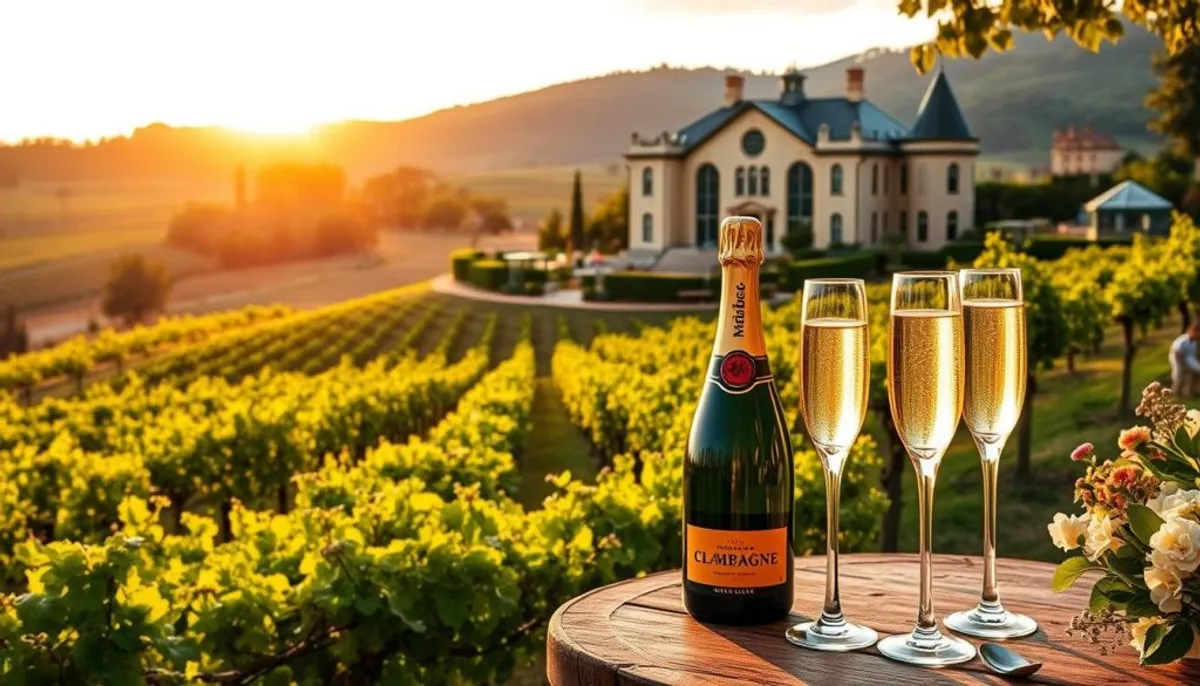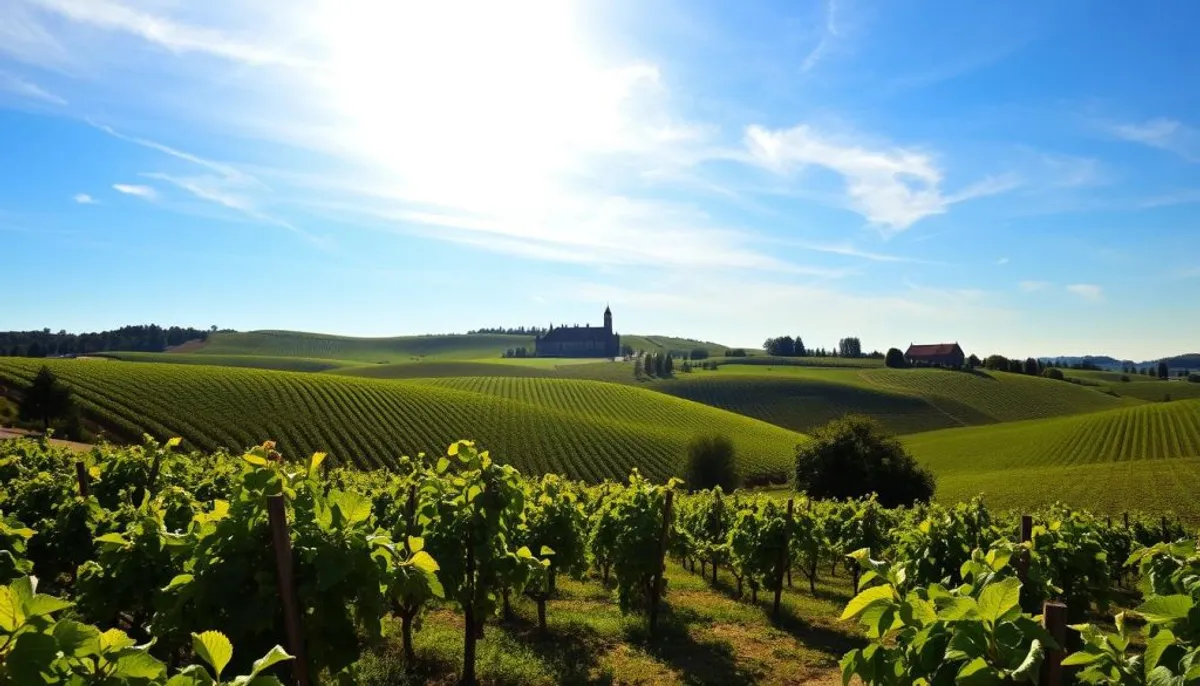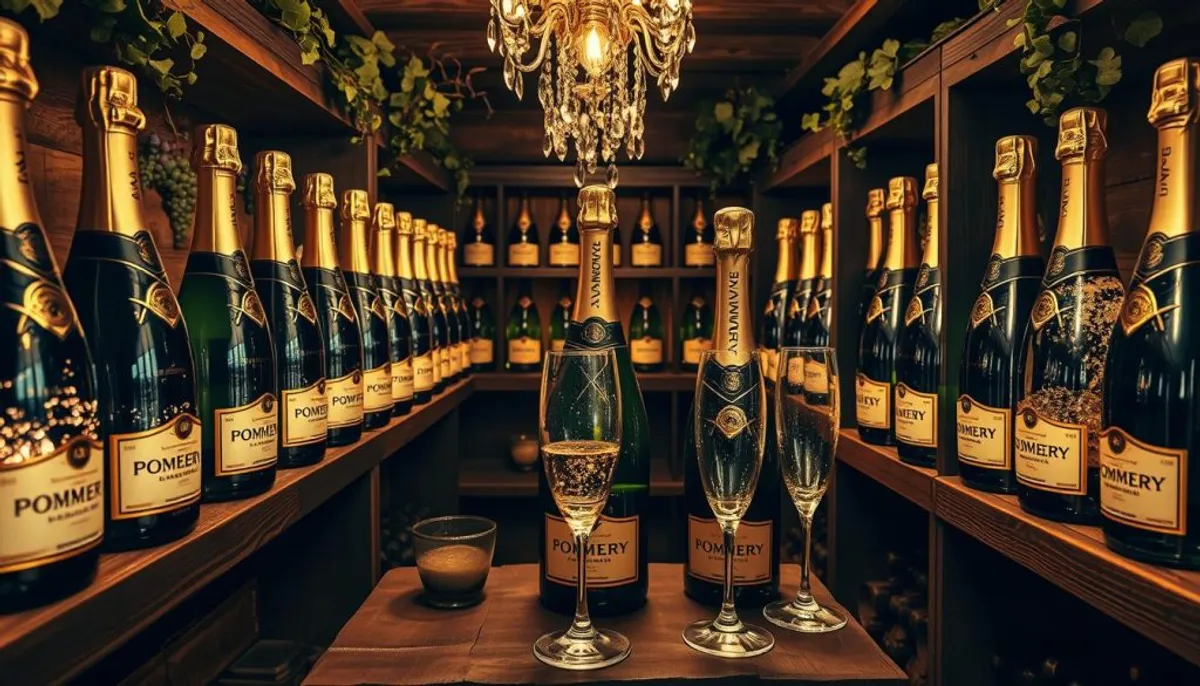Step into the world of Champagne history and luxury wine brands with the remarkable tale of Madame Pommery. In 1860, a 40-year-old widow and etiquette teacher in Reims, France, embarked on a journey that would forever change French winemaking.
Facing numerous challenges, including the Franco-Prussian war, Madame Pommery’s determination led her to create a champagne legacy that continues to inspire. Her story, now immortalized in a book labeled a “Tour-de-Force” by Publisher’s Weekly BookLife Prize, showcases the strength of a woman who dared to dream big in the male-dominated wine industry.

Founded in 1836, Pommery Champagne boasts a rich history spanning over 175 years. Today, it stands as one of the top Champagne houses, producing more than 500,000 cases annually. The Pommery Estate in Reims is a testament to this success, encompassing 125 acres of stunning buildings and gardens.
Madame Pommery’s innovative spirit led to the creation of the world’s first brut champagne in 1874, revolutionizing the industry. This legacy of innovation continues with the Cuvée Louise, launched in 1986, which exemplifies the finest of Pommery’s grand cru wines.
Key Takeaways
- Madame Pommery transformed champagne making in 1860
- Pommery Champagne has a 175-year legacy
- The Pommery Estate covers 125 acres in Reims
- World’s first brut champagne created by Pommery in 1874
- Cuvée Louise launched in 1986, showcasing grand cru wines
- Pommery produces over 500,000 cases of champagne annually
The Rise of Madame Pommery in Champagne Making
In the male-dominated world of 19th-century winemaking, Madame Pommery emerged as a trailblazer for women in the wine industry. Her journey began in 1858 when she took control of Pommery & Greno at the age of 37, following her husband’s death.
Taking Over Pommery & Greno
Madame Pommery’s bold decision to shift from still red wine to sparkling white marked the beginning of a new era for the Pommery estate. This move was risky but proved to be visionary, setting the stage for future innovations in the Champagne region.
Expanding the Finest Vineyards
Recognizing the importance of quality grapes, Madame Pommery acquired some of Champagne’s finest vineyards. This expansion laid the foundation for producing exceptional champagne and solidified Pommery’s position in the competitive wine market.
Breaking Traditional Wine-Making Boundaries
In 1874, Madame Pommery shattered conventions by creating Pommery Nature, the first brut champagne. This drier style challenged the prevailing sweet sparkling wines, revolutionizing tastes and influencing future champagne production.
| Achievement | Year | Impact |
|---|---|---|
| Took over Pommery & Greno | 1858 | Transformed business direction |
| Shifted to sparkling white wine | 1858-1874 | Pioneered new champagne style |
| Created Pommery Nature | 1874 | Introduced first brut champagne |
Creating the World’s First Brut Champagne
In 1874, Madame Louise Pommery transformed the wine industry with Pommery Nature. This dry champagne was a groundbreaking departure from the era’s sweet sparkling wines. It marked a significant shift in champagne production.
Pommery’s innovation involved a drastic reduction in sugar content. From 150 grams per liter to just 30 grams per liter. This change created the world’s first brut-style champagne, setting a new benchmark for the industry.
The influence of Pommery Nature on the champagne world is immense. Today, 92% of all champagne is produced in the brut or dry style. This reflects Madame Pommery’s visionary approach and lasting impact.
| Year | Innovation | Impact |
|---|---|---|
| 1874 | Pommery Nature introduced | First brut champagne created |
| Pre-1874 | Traditional sweet champagne | 150 grams sugar per liter |
| Post-1874 | Pommery Nature | 30 grams sugar per liter |
| Present day | Brut-style dominance | 92% of champagne production |
Pommery’s dedication to quality and innovation remains unwavering. The Pommery Brut Royal Champagne, a modern take on the original, earned 90 points from Wine Enthusiast. This highlights Madame Pommery’s enduring legacy and pioneering spirit.
The Revolutionary Chalk Cellars of Reims
In July 1868, Madame Pommery initiated a groundbreaking project. She acquired 120 limestone and chalk pits, transforming them into a vast underground network. This network was designed for storing and aging champagne bottles.
Transforming Quarries into Wine Cellars
Madame Pommery’s vision culminated in an impressive 18 kilometers of interconnected cellars beneath Reims. This architectural wonder served both practical and symbolic purposes. It became a pivotal element in the region’s wine tourism.
The Architectural Marvel Underground
The Pommery Estate’s underground chalkpit caves now house over 20 million bottles. This architectural achievement is a testament to Madame Pommery’s vision. The cellars attract more than 120,000 visitors each year, making them a major tourist draw.
Art and Wine: The Fete du Bacchus Frieze
Madame Pommery’s passion for art is reflected in the cellars. She commissioned the ‘Fete du Bacchus’ frieze, merging wine culture with artistic expression. Today, the Estate continues this legacy by hosting contemporary art exhibitions in its underground caves. This offers a unique experience for both wine enthusiasts and art aficionados.
| Feature | Details |
|---|---|
| Cellar Length | 18 kilometers |
| Bottle Capacity | Over 20 million |
| Annual Visitors | 120,000+ |
| Unique Attraction | Contemporary Art Exhibitions |
The Vranken-Pommery Monopole Empire Today
Vranken-Pommery Monopole has emerged as a dominant force in the global wine market. Spanning 2,600 hectares, its vineyards are strategically located in Champagne, Provence, Camargue, and Douro. This vast expanse solidifies its standing among the champagne industry’s elite.
In 2023, Pommery marked a significant milestone: the 150th anniversary of Madame Pommery’s groundbreaking introduction of Brut Champagne. This event underscores the brand’s lasting impact and its role as a pioneer in the champagne sector.

The company’s dedication to excellence is evident in its premium cuvées. The Cuvée Louise, introduced in 1979, exemplifies unparalleled purity. It is crafted from the finest grapes in Avize, Cramant, and Aÿ. To celebrate their 175th anniversary, Pommery unveiled the Clos Pompadour in 2011. This exclusive champagne originates from 25 hectares within the Domaine Pommery’s walls.
Vranken-Pommery Monopole is at the forefront of sustainable practices. Currently, 175 hectares in Champagne are transitioning to organic viticulture. Their estates in Camargue and Provence are almost entirely organic, with 2000 hectares certified. Their Portuguese estate, Quinta do Grifo, initiated organic conversion in 2020. Additionally, they offer a premium champagne, gh mumm, which exemplifies their commitment to quality and sustainability.
The brand’s influence transcends wine production. Pommery supports The Armory Show art fair, offering a $20,000 prize to artists and galleries. This commitment to the arts reflects the company’s broader dedication to culture and innovation, cementing its status as a global wine production leader.
Sustainable Practices and Environmental Commitments
Vranken-Pommery is at the forefront of sustainable winemaking. The brand’s commitment to eco-friendly viticulture is evident through its innovative practices. By 2021, a remarkable 97% of their vineyards were organic certified or in the process of conversion.
Organic Viticulture Initiatives
Pommery’s commitment to organic vineyards is evident. Provence achieved 100% organic certification in 2021, with Camargue following in 2023. These efforts significantly boost biodiversity and soil health, ensuring the highest quality grapes for their celebrated champagnes.
Water Conservation Methods
Water management is a cornerstone of Pommery’s eco-friendly approach. They employ advanced irrigation systems and rainwater harvesting to minimize water waste. This not only conserves a vital resource but also enhances grape quality.
Eco-Friendly Transportation Solutions
Pommery addresses emissions with intelligent transportation choices. They utilize electric vehicles for vineyard operations and optimize shipping routes to decrease carbon output. These measures significantly reduce their carbon footprint while preserving product excellence.
| Sustainable Practice | Implementation | Impact |
|---|---|---|
| Organic Viticulture | 97% of vineyards certified or in conversion | Enhanced biodiversity, improved soil health |
| Water Conservation | Advanced irrigation, rainwater harvesting | Reduced water waste, better grape quality |
| Eco-Transportation | Electric vehicles, optimized shipping | Lower carbon emissions, maintained product quality |
The Art of Pommery Rosé Champagne
Pommery’s rosé champagne exemplifies the brand’s dedication to innovation and quality. This exquisite blend is a result of the art of sparkling wine blending. It combines red and white wines to create a unique flavor profile.
The Pommery Brut Rosé Royal captivates wine enthusiasts with its rose gold hue and delicate bubbles. During wine tasting sessions, connoisseurs note its complex aroma, featuring hints of cherry and orchard blossoms. The palate offers a delightful mix of tart cherry flavors, complemented by subtle mineral notes and a fennel-like finish. The experience is further enhanced by the option of pairing it with a demi sec, adding a sweet contrast to the wine's profile.
Crafted for sparkling wine production, the red wine component adds depth and character to the blend. The white wines, mainly Chardonnay, contribute crispness and elegance. This careful balance results in a rosé champagne that’s both refreshing and sophisticated.
To celebrate 150 years of brut champagne, Pommery has created a special edition cuvée called Apanage 1874. This anniversary blend will be featured alongside the Brut Rosé at prestigious events like Art Basel. It showcases the brand’s enduring legacy in the world of fine sparkling wines.
Madame Pommery’s Cultural Impact
Madame Pommery’s influence on the realms of art and wine is profound. Her fervor for art patronage and cultural preservation reshaped Reims and its surroundings. She championed women’s empowerment, a rare stance in her time, opening doors for future generations in the wine sector.
Contributions to Reims Museum of Fine Arts
Her philanthropy revolutionized the Reims Museum of Fine Arts. Through significant donations, the museum broadened its collection, spotlighting works that honored the “new” woman of the Belle Epoque. This vision underscored her dedication to cultural advancement and women’s empowerment.
Supporting Women in Wine Industry
Madame Pommery’s impact on women in the wine industry remains significant. By her death in 1890, she had expanded markets to 80 countries, demonstrating her business prowess and global perspective. Her legacy is seen in the evolving Champagne world, where women increasingly hold pivotal roles.
- Pommery and Duval-Leroy are among the few large Champagne houses owned by women
- Since 2002, Domaine Pommery cellars host annual art exhibitions, attracting 135,000 visitors yearly
- The POP Range, featuring art commissions on labels, offers a 15,000-Euro grant to young international artists
The Vranken family continues Madame Pommery’s legacy, blending champagne production with art patronage. This ensures her cultural impact remains vibrant.
The Mother-Daughter Legacy Continues
The champagne tradition at Pommery is sustained by a remarkable mother-daughter duo. Nathalie and Pauline Vranken uphold the legacy of Madame Pommery, embodying the essence of women winemakers. Their leadership at Vranken Pommery Monopole exemplifies the lasting impact of family-owned wineries in Champagne.
Nathalie and Pauline honor Madame Pommery’s innovative spirit by merging traditional methods with contemporary approaches. They’ve ensured the brand’s relevance in the champagne industry while remaining faithful to its heritage. This synthesis of tradition and innovation is evident in their winemaking and business strategies.

The duo’s most significant contribution is the annual “Experience Pommery” exhibition. Held in the historic Gallo-Roman chalk cellars, this event celebrates the fusion of art and wine. It pays homage to Madame Pommery’s passion for the arts and her vision of champagne as a cultural experience.
| Aspect | Madame Pommery’s Era | Vranken Era |
|---|---|---|
| Leadership | Single visionary | Mother-daughter duo |
| Focus | Breaking traditions | Balancing tradition and innovation |
| Art Integration | Personal passion | Annual exhibition |
| Market Reach | Expanding local market | Global brand presence |
The Vrankens’ dedication to quality and originality in winemaking mirrors Madame Pommery’s pioneering approach. They continue to innovate while honoring the champagne tradition that has solidified Pommery’s reputation. This balance ensures Pommery remains a symbol of excellence in the champagne world.
Pommery’s Global Vineyard Portfolio
Pommery’s wine estate management extends across varied regions, demonstrating its dedication to global viticulture. The winery’s extensive portfolio showcases a profound grasp of terroir diversity. This enables it to craft an array of outstanding wines.
Champagne Region Holdings
Pommery’s core vineyard holdings are centered in the Champagne region. The winery commands 300 hectares of Grand Cru vineyards on the esteemed Montagne de Reims and Côtes de Blancs. These prime locations are pivotal in the creation of Pommery’s signature Champagnes. Notably, the Brut Royal combines nearly 40 different vintages.
International Vineyard Expansion
Pommery’s global viticulture endeavors transcend Champagne. The winery has broadened its scope to include vineyards in Provence, Camargue, and Douro. This international expansion enables Pommery to explore novel terroirs and broaden its wine offerings. In a daring step, Pommery has also ventured into English sparkling wine production. It owns a vineyard in Hampshire, set to yield its inaugural harvest soon.
Under the stewardship of Chef de Caves Clement Pierlot, who joined Pommery in 2004, the winery continues to innovate while respecting its storied heritage. Pierlot’s mastery in blending wines from diverse terroirs ensures each Pommery bottle captures the essence of its origin. Whether it’s a classic Champagne or an innovative offering from their global portfolio, each bottle is a testament to Pommery’s commitment to excellence.
Modern Innovation While Honoring Tradition
Champagne Pommery is a leading example of innovation in the wine sector. It merges advanced wine technology with traditional champagne methods. This fusion enables Pommery to produce outstanding wines while preserving its heritage.
To mark 150 years of Brut Champagne, Pommery introduced the Cuvee Apanage 1874. This exclusive blend honors Madame Pommery’s pioneering work from 1874. The brand’s commitment to sustainability is evident in transporting this cuvee to America by sailboat. This mirrors the historic journey of Pommery champagne aboard the Foudre de Gale over 120 years ago.
Pommery’s commitment to innovation goes beyond winemaking. It integrates art and culture into its ethos, as seen at The Armory Show. There, Pommery awarded its sixth Pommery Prize to Bahamian artist Anina Major, offering $25,000. This event showcases Pommery’s unique fusion of luxury, art, and history.
| Year | Innovation | Impact |
|---|---|---|
| 1874 | First Brut Champagne | Revolutionized champagne taste |
| 2024 | Cuvee Apanage 1874 | Commemorates 150 years of Brut |
| Ongoing | Sustainable practices | Eco-friendly transportation |
Through these efforts, Champagne Pommery continues to redefine wine technology while respecting its heritage. The brand’s dedication to excellence, sustainability, and cultural engagement ensures Madame Pommery’s visionary legacy is celebrated in every bottle.
The Perfect Pommery Champagne Pairings
Pommery Champagne presents a collection of exquisite wines, designed to elevate any gastronomy experience. For those passionate about food and wine pairing, Pommery’s offerings are both versatile and exciting. This exploration delves into culinary recommendations and tasting profiles, aiming to enrich your champagne tasting journey.
Culinary Recommendations
The Pommery Brut Royal, a non-vintage champagne, pairs exceptionally well with a variety of dishes. Its crisp acidity and balanced flavors make it a perfect match for appetizers, seafood, and soft cheeses. For a truly delightful pairing, consider it with jean laurent champagne:
- Bluefish or whitefish
- Fowl dishes
- Seafood platters
- Soft cheese boards
Tasting Notes and Profiles
Pommery champagnes provide unique tasting experiences. The Brut Royal, with an alcohol content of 12.5%, is best served between 4ºC and 8ºC. Its optimal consumption period is 2017-2018, highlighting the wine’s peak flavors.
For a special occasion, the Apanage Brut 1874 is a standout. This blend commemorates 150 years since Louise Pommery’s pioneering brut champagne. It combines vintages from 2012, 2015, and 2018, resulting in a complex flavor profile.
| Champagne | Tasting Notes | Food Pairing |
|---|---|---|
| Pommery Brut Royal | Crisp, balanced, versatile | Seafood, soft cheese |
| Apanage Brut 1874 | Complex, multi-vintage blend | Fine dining, celebratory meals |
| Cuvée Louise 2005 | Grand Cru, aged 6-8 years | Luxurious dishes, truffle-based cuisine |
Conclusion
Madame Pommery’s champagne legacy shines brightly, 150 years after she introduced the world’s first brut champagne. The House of Pommery marks this occasion with two exceptional cuvées. These wines capture the heart of French wine heritage and the pinnacle of luxury.
The Cuvée 150, a blanc de blancs extra brut, honors Pommery’s pioneering spirit. Made from Chardonnay from renowned vineyards, it aged for six years on lees. With a production of just 10,000 bottles, it offers a rare glimpse into Pommery’s finest.
Complementing Cuvée 150, Pommery presents Apanage 1874, a tribute to the brand’s gastronomic and Chardonnay legacy. These new releases not only celebrate Pommery’s storied past but also underscore its ongoing pursuit of winemaking excellence. Amidst the champagne market’s challenges, Pommery’s unwavering commitment to quality and innovation solidifies its status as a luxury wine leader.
RelatedRelated articles



